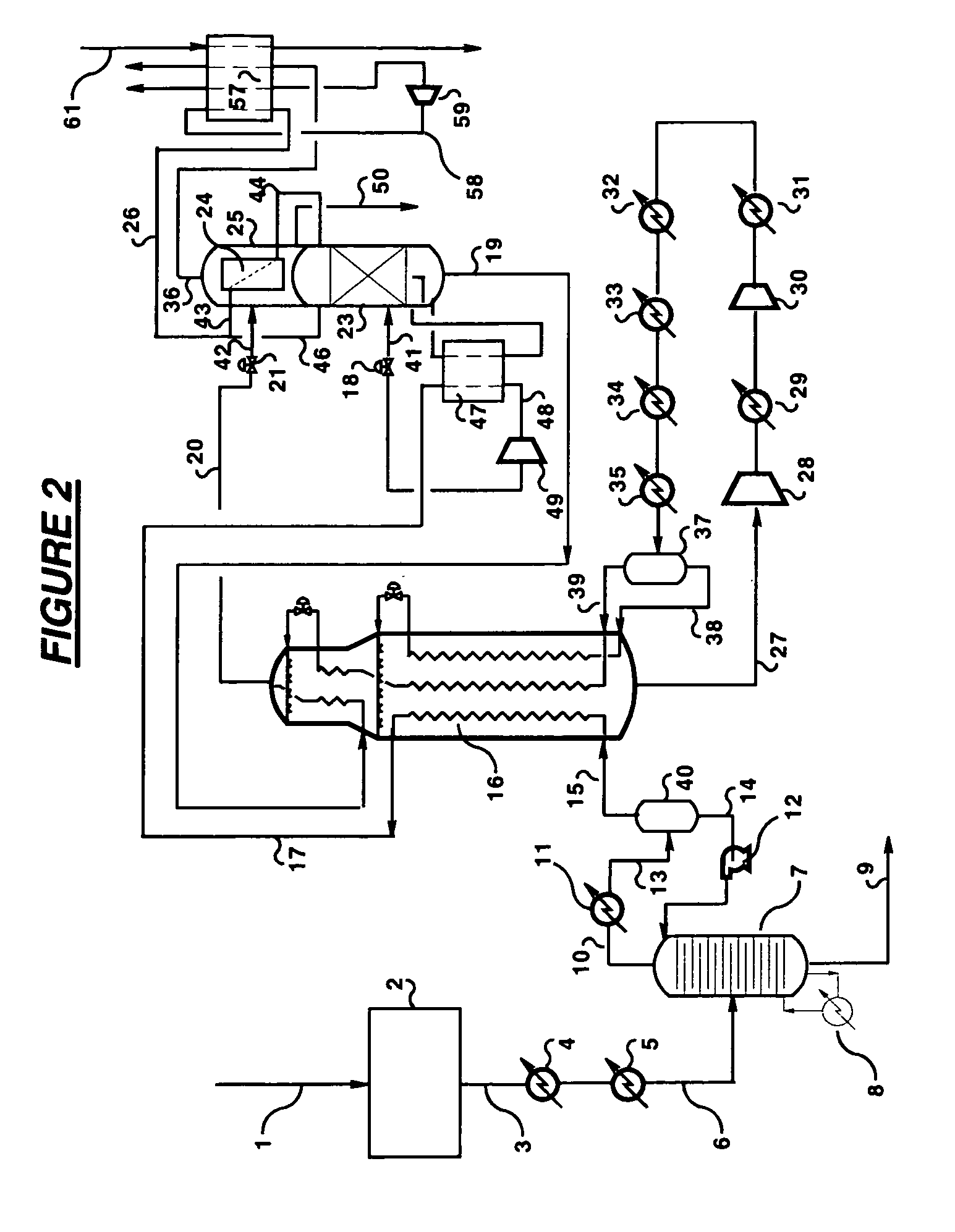Dual stage nitrogen rejection from liquefied natural gas
a technology of liquefied natural gas and nitrogen rejection, which is applied in the direction of lighting and heating apparatus, refrigeration machines, solidification, etc., can solve the problem of low nitrogen tolerance in the fuel gas, and achieve the effect of minimal additional equipment and minimal impact on plant performan
- Summary
- Abstract
- Description
- Claims
- Application Information
AI Technical Summary
Benefits of technology
Problems solved by technology
Method used
Image
Examples
example 1
[0090]This Example is based on the embodiment of FIG. 1. The LNG process is supplied with 88,000 lbmol / h (40,000 kgmol / h) feed natural gas at ambient temperature and 900 psia (6.2 MPa) pressure containing 4.8 mol % nitrogen, the balance being mainly methane. The feed gas is dried and precooled and pretreated in separation column 7 such that it enters heat exchanger 16 at a temperature of −38° F. (−39° C.) and a pressure of about 850 psia (5.8 MPa). Stream 17 leaves heat exchanger 16 at a temperature of −178° F. (−116.5° C.) and is let down in pressure to 220 psia (1.5 MPa) before feed to nitrogen-rejection column 23, which operates at 220 psia (1.5 MPa). Stream 19 is withdrawn from the bottom of the column 23 and is further cooled to −247° F. (−155° C.) in heat exchanger 16. Stream 20 leaving the heat exchanger 16 is then let down to low pressure into flash drum 25. Product LNG stream 50 is withdrawn from flash drum 25 at a temperature of −261° F. (−163° C.) with a nitrogen content ...
example 2
[0091]This Example is based on the embodiment of FIG. 1 with the enhancement of crude helium extraction of FIG. 5. The LNG process is supplied with 88,000 lbmol / h (40,000 kgmol / h) feed natural gas at ambient temperature and 900 psia (6.2 MPa) pressure containing 4.8 mol % nitrogen and 600 ppmv helium, the balance being mainly methane. The feed gas is dried and precooled and pretreated in separation column 7 such that it enters heat exchanger 16 at a temperature of −38° F. (−39° C.) and pressure of about 850 psia (5.9 MPa). Stream 17 leaves heat exchanger 16 at a temperature of −178° F. (−116.5° C.) and is let down in pressure to 220 psia (1.5 MPa) before feed to nitrogen column 23, which operates at 220 psia (1.5 MPa). Stream 19 is withdrawn from the bottom of the column 23 and is further cooled to −247° F. (−155° C.) in heat exchanger 16. Stream 20 leaving the heat exchanger 16 is then let down to low pressure into flash drum 25. Product LNG stream 50 is withdrawn from flash drum 2...
PUM
 Login to View More
Login to View More Abstract
Description
Claims
Application Information
 Login to View More
Login to View More - R&D
- Intellectual Property
- Life Sciences
- Materials
- Tech Scout
- Unparalleled Data Quality
- Higher Quality Content
- 60% Fewer Hallucinations
Browse by: Latest US Patents, China's latest patents, Technical Efficacy Thesaurus, Application Domain, Technology Topic, Popular Technical Reports.
© 2025 PatSnap. All rights reserved.Legal|Privacy policy|Modern Slavery Act Transparency Statement|Sitemap|About US| Contact US: help@patsnap.com



